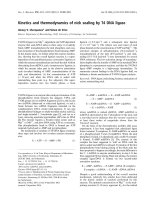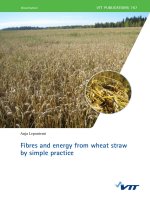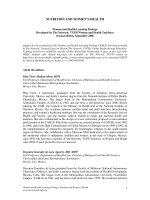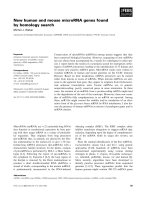NLP and ML behind chatbots talk by shubhi saxena
Bạn đang xem bản rút gọn của tài liệu. Xem và tải ngay bản đầy đủ của tài liệu tại đây (2.52 MB, 18 trang )
Hacking into the
NLP and ML
behind
Chatbots
Shubhi Saxena
Product Manager,
Yellow messenger
Why are enterprises talking about chatbots?
•
No friction
•
Instant answers
•
Always available
•
Automated Actions
•
Natural conversations
•
Personalised experiences
•
Bots don’t forget or judge!
Let’s meet some real
bots!
(Live Showcase)
How do chatbots work?
Present State of Language Technology
import nltk
sentence = “Awesome to be at Pyladies!”
token = nltk.word_tokenize(sentence)
nltk.pos_tag(token)
Basic Text Processing
•
Tokenisation - language issues, proper noun issues, abbreviations,
periods, symbols, OOV words, etc.
•
Normalisation & stemming (e.g. U.S., US, U.S.A. —> usa ; case
folding)
•
Lemmatisation (the boy’s cars are different colors → the boy car be
different color)
•
Stemming (e.g. automate(s), automatic, automaton - all reduced to
automat.
•
Sentence segmentation (difficult in speech-to-text processing)
Intro to n-Grams
Word embeddings
•
Word embeddings are distributed representations of text in an n-dimensional space (to bridge
the gap between human understanding and machines).
•
•
One-hot encoding : vector the size of label array - not efficient
Word2vec takes as its input a large corpus of text and produces a vector space, typically of
several hundred dimensions
•
•
Each unique word in the corpus is assigned a corresponding vector in the space.
Word vectors are positioned in the vector space such that words that share common contexts
in the corpus are located in close proximity to one another in the space.
•
Other models : Glove (co-occurence) , fastText (character level representation)
NLU in chatbots : Intent Classification
•
•
•
•
•
•
•
•
What is an intent
What are word embeddings
What is a classifier
What are classification features
Drawbacks of this approach
Alternative - Train word embeddings from scratch using domain-specific
data (supervised embeddings)
How to choose?
Challenges - similar intents, multiple intents, skewed data, OOV words
Parts of Speech Tagging
•
Eight parts of speech taught in English but more can be
used for practical purposes in NLP
•
Use-Cases : NER, IE, TTS pronunciation, input to a parser
•
Useful features -
•
Knowledge of neighbouring words
•
Word probabilities
•
Word structure (prefix, suffix, capitalisation, symbols,
periods, wird shapes, etc.)
Information Extraction(IE)
•
Goals of Information Extraction-
• Organise information so that it can be consumed by people
• Convert information into a precise semantic format on which computer
algorithms can run inferences.
•
Simple task - Extract clear, factual information from documents
•
Example - Mail clients automatically detect dates and offer to schedule
meeting/block calendar
•
Difficult - Word meaning Disambiguation and combining different sources of
related data to derive inferences
NLU : Named Entity Recognition (NER)
•
•
•
•
•
•
Sub-task of IE - Identify and classify ‘entities’ in texts
What are entities? How can we use them in chatbots?
Rule-based : Facebook’s duckling (demo) - ordinal, duration, date, etc.
Pre-trained models : SpaCy (Try here) - person, organisation, place, etc.
Custom entity detection (annotation)
Challenges - fuzzy entities, extracting addresses, and mapping of extracted
entities
Sequencing using Conditional Markov Models
Now let us look at this again!
Further Reading
•
Stanford’s Intro to NLP course by Dan Jurafsky - link
•
Spacy crash course - link
•
We could not discuss Text Classification - Google’s Crash
course link
•
Metablog by Pratik Bhavsar (if you want to go Ninja) - link
We are Hiring!
Shubhi Saxena









